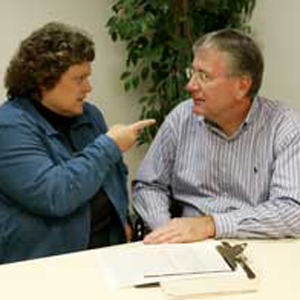
Approaching Care for Difficult Behavior
DescriptionThis program provides an introduction to the different types of difficult or challenging behaviors, potential causes for the behavior, and methods to cope with, reduce or prevent the incidence of these behaviors when working with any patient.
This course is part of the Home Health Aide/Nursing Assistant Training library designed for agency or education institution use as an educational aid and resource in conjunction with hands-on instruction in a lab and or clinical setting supervised by a nurse educator. The agency or education institution is responsible for ensuring the learner has attained the knowledge and care skills, according to their state's requirements, before providing care to a client.
This is a self-paced course with optional knowledge check quizzes after each lesson. These non-graded quizzes allow you to check your understanding of the lesson objectives before proceeding to the next lesson. After the final lesson you will be required to take the final exam. You must score 70% or higher to pass the course and obtain a certificate of completion.
- Define difficult behaviors
- Identify different types difficult behaviors
- State the significance of difficult behaviors
- Identify the ABC's of behavior
- State the significance of activating agents (triggers)
- Identify the consequences of behavior
- Identify methods to enhance the patient's feeling of belonging and safety
- Outline ways to increase patient control
- Explain the importance of consistent routines in patient care
- Identify 2 potential environmental triggers and methods to minimize them
- Identify 2 potential physical triggers and ways to minimize them
- Outline the importance of emotional triggers
- Describe the impact of your verbal and non-verbal communication on patient behavior
- Compare and contrast the components of effective communication
- Identify the steps in demonstrating a listening approach
- Identify when a behavior becomes a problem
- State how to demonstrate valuing a person's feeling
- Identify actions to take to re-direct a person to another activity
- Outline how to value a person's past
- Identify when it is appropriate to temporarily step away from a situation
- Outline the appropriate use of patient isolation and restraints
- Outline specific care strategies for dealing with:
- Personal Care challenges
- Vocal Behavior challenges
- Paranoia and suspicion
- Hallucinations and delusions
- Isolation and withdrawal
- Demonstrate Methods to Manage and Decrease Patient Aggressive or Agitated Behavior
- Identify different professionals available to assist in addressing challenging behaviors
- State the importance of support groups for the patient and family.
2.5 Contact Hour: based on 60 minute contact hour
The estimated time for completion for this activity is 2.5 hour(s).
This course is designed to meet the continuing education requirements of healthcare paraprofessionals, such as homehealth aide, nurses aide and personal care attendants.
Kathy Richie - BSN RN Program Director Allied Health Continuing Education Rochester Community and Technical College
Kathy Richie received her Bachelors of Science Degree in Nursing from the College of St. Teresa with a minor in Psychology. She has over 13 years experience in the health care field and a decade of experience in the design, development and provision of adult/healthcare professional continuing education. Kathy also serves as director of the Heartland Regional Geriatric Education Center for southeastern Minnesota, which is supported by the Minnesota Area Geriatric Education Center, part of the University of Minnesota's Center on Aging.
Kathy is a member of the Program Services Committee of the Alzheimer's Association, Minnesota - North Dakota Chapter as well as a member of the Leadership Council for the Alzheimer's Association Southern Minnesota Regional Center.
Materials used in connection with this course may be subject to copyright protection. Retention of the materials for longer than the class term, unauthorized further dissemination of the materials, or use of copyrighted materials in any way other than intended for this class is prohibited by Copyright and Teach Act laws.
This course was developed with Rochester Community and Technical College's Continuing Education and Workforce Development Division located in Rochester Minnesota. Development was funded from the Minnesota State Colleges and Universities System.